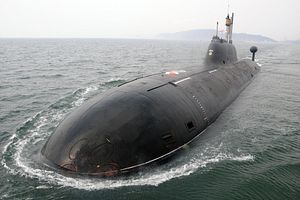In December 2014, Russian President Vladimir Putin traveled to India, traditionally a major consumer of Russia-made military equipment. In New Delhi, Putin met Indian Prime Minister Narendra Modi and the two pledged to deepen their defense ties. During that visit, Russia’s trade minister, Denis Manturov, hinted that Moscow would eagerly lease a nuclear submarine to India if there was interest: “If India decides to have more contracts to lease nuclear submarines, we are ready to supply,” he noted. India currently operates one Akula-II-class nuclear submarine, the INS Chakra, leased in 2011 from Russia for a 10 year period. The lease weighs in at $970 million, representing a considerable portion of India’s cumulative spending on Russian equipment.
The Russian minister’s comments were not entirely out of left field: Indian defense ministry officials had told the press that the Indian Navy would acquire another nuclear submarine from Russia. After December, information surrounding a potential second submarine lease died down — until this week. The Russia and India Repor noted last week that a Russian shipbuilding industry source noted that “Russia is ready to lease a second Project 971 Shchuka-B submarine to India for a period of ten years.” The report continues:
The submarine will be customized by the Amur shipyards. Modernization and testing of the submarine and training of the Indian crew will take three years. The Kashalot will be transferred to the Indian Navy in 2018, the source noted.
The specific submarine to be leased is the K-322 Kashalot, an Akula-II-class submarine (Akula is the NATO reporting name for the Shchuka) with a surface displacement of 8,140 tons, submerged speed of 30 knots, and maximum operating depth of 520 meters. The Kashalot additionally requires a crew of 73 sailors and uses a 190 mW nuclear reactor for propulsion. The Kashalot features eight torpedo tubes in total, with four bays designed for 630 mm torpedoes and the remainder designed for 533 mm torpedoes (optimized for Russian-made Type 65 and Type 53 torpedoes).
In a separate report earlier last week from Russia’s state-run TASS news agency, a “high-placed source in the system of Russia’s military and technical cooperation with foreign countries” notes that “In January this year, the Indian side suggested transferring the second project 971 multipurpose nuclear submarine Kashalot for lease.” He adds that “the Russian side is studying the issue.” “The procedure will most likely be similar to the procedure, which was used for transferring the first submarine called Nerpa to the Indian side,” TASS‘ source adds.
In addition to the INS Chakra, India is currently conducting sea trials for an additional nuclear submarine, the indigenously developed INS Arihant. India has an additional three submarines planned as part of the Arihant-class. The major distinction between India’s Akula-class and Arihant-class is that the latter is an SSBN and a critical part of ensuring a robust nuclear triad for New Delhi. The INS Chakra and the K-322 Kashalot are attack submarines, intended for anti-surface combat, sea-denial, and coastal defense purposes.
India’s submarine procurement plans were defined primarily by a thirty-year plan, conceived of in the late-1990s, which envisages a modernized submarine force consisting of submarines acquired in equal parts from the West and Russia, complemented by an indigenous design.
































